Joachim Held lute
59:00
hänssler classic CD HC19034
Click HERE to buy this CD on amazon.
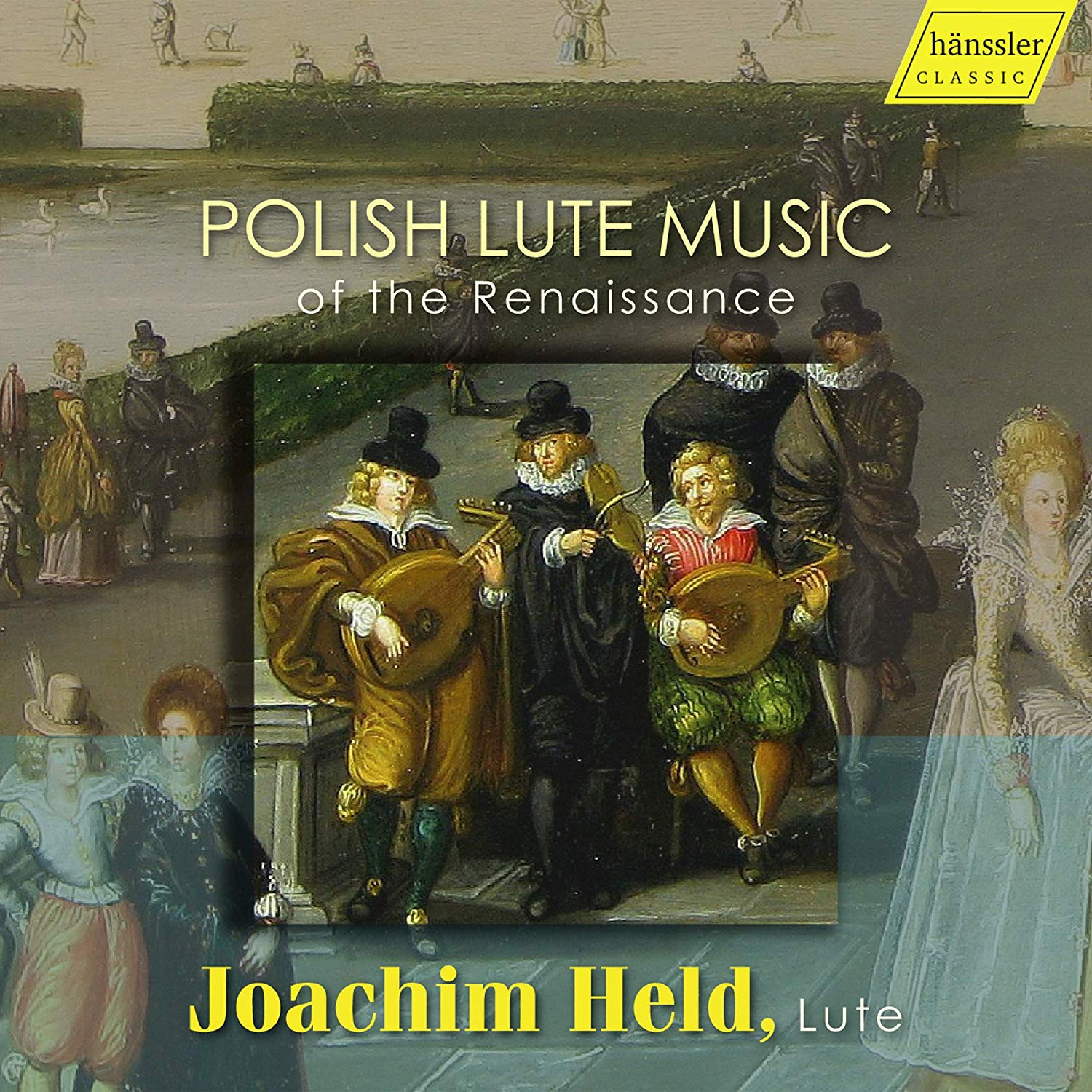
Joachim Held lute
59:00
hänssler classic CD HC19034
Click HERE to buy this CD on amazon.
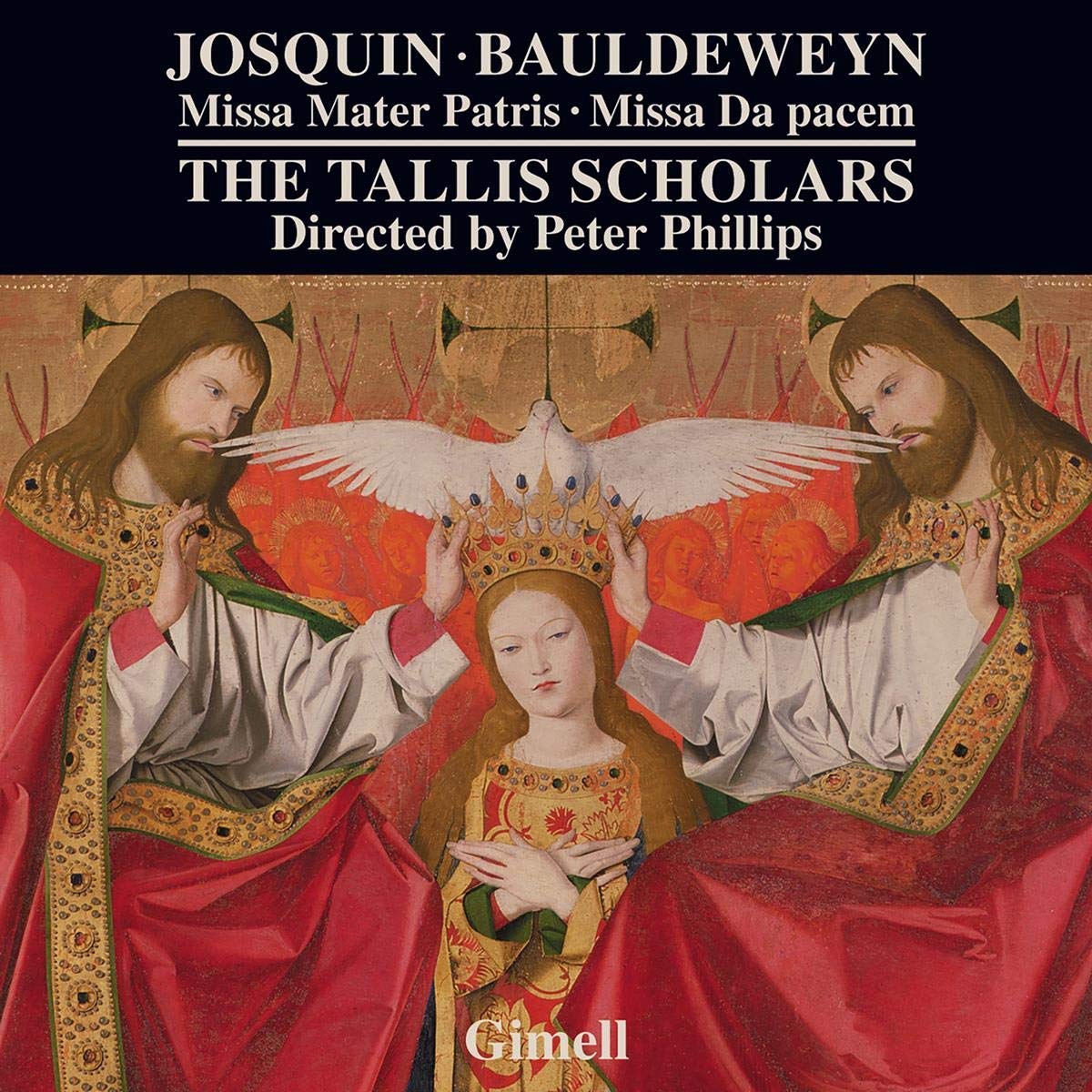
The Tallis Scholars, directed by Peter Phillips
72:30
Gimell CDGIM 052
+Brumel Mater Patris, Plainchant Da pacem
There is so much that is fine about this recording, i.e. everything, that it is difficult to know where to begin. Best perhaps with the pieces themselves. The Missa Mater Patris by Josquin Des Pres – if indeed it be by him – is an astounding creation. Written in four parts, with a fifth added for the third Agnus Dei, it is unique among his masses in referring to a work by another composer, Antoine Brumel, who was seemingly only a decade younger than Josquin. Because it is unique among Josquin’s masses, both in provenance and in musical style, it is inevitable that the revisionist police come sniffing round, eager to remove it from Josquin’s canon. Scarcely less impressive, the Missa Da pacem survives with attributions to Mouton, Josquin and Bauldeweyn in early sources, and throughout the nineteenth and into the twentieth centuries it was hailed as one of Josquin’s greatest compositions. Then in 1972, according to Peter Phillips’s cogent notes, Edgar Sparks established that it was the work of Noel Bauldeweyn, who flourished during Josquin’s lifetime. There is a commercial recording of four of his masses by the excruciatingly named but capable Beauty Farm, an ensemble based in Austria, on Fra Bernardo FB1709761, a double album.
What of the music itself? Mater Patris, the euphonious three-part motet by Brumel on which the Missa Mater Patris is based, is constructed largely of duets followed by short passages in all three parts. Josquin’s fuller punctuations tend to be homophonic, with harmonies and textures that glow gloriously, a quality that sets it apart from his earlier more polyphonic masses. Particularly memorable – one wants to say catchy but the context might be too serious – is his response to the word Hosanna and, while Brumel’s setting of the word “exaudi” lurks throughout the mass, here Josquin gives it full rein. Peter Phillips’s notes are excellent and, although I would take with a pinch of salt his suggestion that Josquin’s setting of Hosanna exhibits playfulness, it certainly shows a human side to this most technically assured of composers. While still showing maximum homage to Brumel, Josquin flexes his polyphonic muscles towards the end of the third Agnus in five parts, resulting in music emulated at the same point only by Palestrina and, particularly, Byrd. One corker of a dissonance at 4’05 left this listener breathless.
Missa Da pacem also in four parts, based on the plainchant “Da pacem, Domine”, is eminently fit to be mentioned in the same sentence as Josquin even though it has been established as a work of Bauldeweyn. Besides those fine passages (especially the fabulous third Agnus in six parts) mentioned in his notes by PP, the first Kyrie, Benedictus and first Agnus in particular present the work of a composer who, at his best, is comparable in stature to Josquin as, say, Alonso Lobo is to Victoria.
Recently I attended a concert by The Tallis Scholars under Peter Phillips at the Cadogan Hall in London, at which they performed Palestrina’s neglected but superb Missa Ave Maria a6, plus motets by Byrd (including his disorientatingly discordant six-part setting of O salutaris hostia described amusingly but accurately in the programme notes as “bonkers”), Handl, Morales and Palestrina again, with a neglected Magnificat by him to conclude. Their live singing was as good as I have ever heard it, and the same can be said about their recorded singing on this disc. They present the best possible case for these two masses, supported by outstanding sound engineering in which every part is equally audible and perfectly balanced.
Even after all this exhaustive advocacy I am still not sure that I have done this superlative disc adequate justice. Suffice to say, everything about it is the best.
Richard Turbet
Click HERE to buy this disc on amazon.
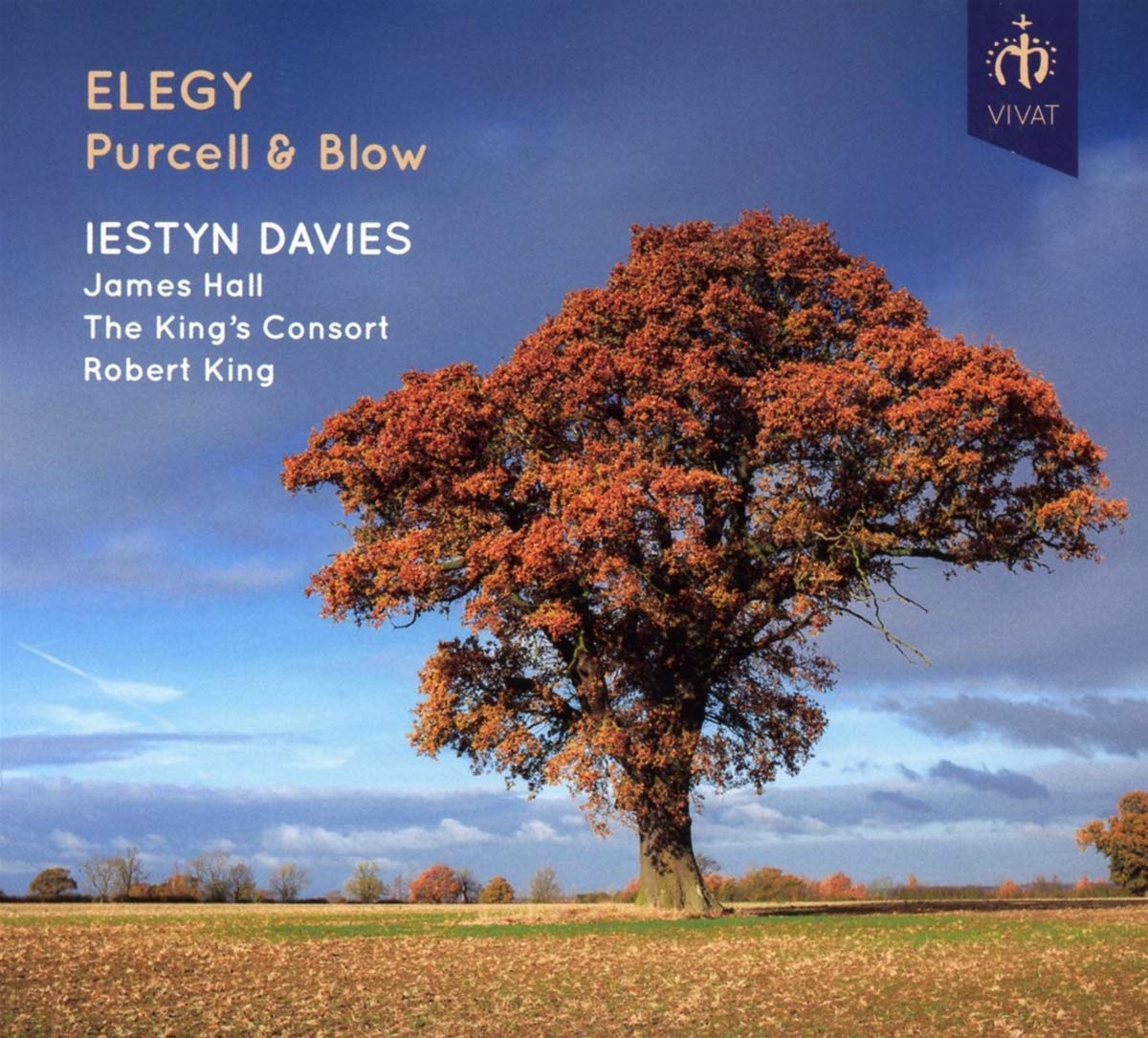
Duets for the countertenor or high tenor voice – often not easy to distinguish between – were popular repertoire during the Restoration, the CD under review featuring a number of well-known examples such as Purcell’s ‘Sound the trumpet’ from the ode Come ye sons of art, ‘O solitude’ and ‘O dives custos’, one of the elegies written to commemorate the death of Queen Mary in 1695, and John Blow’s moving ‘Ode on the death of Mr Henry Purcell’, the most extended work on the disc. There are also a number of solos sung by Davies.
There is therefore rather a concentration on sombre or more reflective topics that seems to have cast something of pall over the CD as a whole. It gets off to a good start with the bright warblings of ‘Hark how the songsters’ from Timon of Athens, Shadwell’s adaptation of Shakespeare. Here the two voices expertly combine with a pair of recorders to weave a colourful tapestry of sound in one of the more agreeable of the Baroque’s ubiquitous bird songs. The following ‘In vain the am’rous flute’ from the Ode for St Cecilia’s day Hail, bright Cecilia is admirable for the sheer sweetness of the sound and the musical way in which the two voices shape the long, melismatic lines. Yet nagging questions start to arise. Does the slow tempo chosen leave it sounding somewhat pedestrian? Is the less than clear enunciation responsible for the lack of engagement felt by at least this listener? A pattern is thus established that extends for the remainder of the disc. The voices are beautifully matched and duet together sympathetically, but is difficult to avoid a feeling of ever-encroaching blandness. Just occasionally something more potent arises, such as Iestyn Davies’ ‘Incassum Lesbia’, particularly at the heartfelt words ‘Regina, heu Arcadiae regina’, where he finds an emotional response to the text not often in evidence elsewhere.
As it happens, over 30 years ago, Robert King recorded for Hyperion a record with almost the same content sung by an earlier generation of countertenors, James Bowman and Michael Chance. I dug it out to find whether it confirmed my impressions of the new disc, which it unquestionably does. Everything on the older recording is brighter, more alive, even the more sober numbers having a deeper expressive quality than those on the new CD. Neither is the presentation on the latter as good, with no source or Z number given in the contents listing, as it was on the Hyperion. The disc will doubtless please the many admirers of Iestyn Davies – though it is worth noting that the lesser-known James Hall is by no means overshadowed – but to my mind it is another reminder that the last quarter of the 20th century was a golden age for the British early music revival.
Brian Robins
Click HERE to buy this CD on amazon.

Elephant House Quartet
58:56
Pentatone PTC 5186 749
It is with some inevitability that any baroque flautist or recorder player will come to “dabble”, adding their individual flair and sheen to some of Telemann’s neatly conceived, oft charming little gems of chamber music. Many pieces also offer a surprising flexibility in options for possible instrumentation. Here the Elephant House Quartet bring a crisp and balanced interpretation of works chosen to share the limelight, then slip back into the comfortable nucleus of the quartet; this they do with amazingly smooth, unforced ease. The recorder version of the Paris Quartet (TWV43:G4) and the Suite V in A minor (TWV42:a3) display these precise qualities so very well. Camerata Köln recorded the complete “Six Concerts et six Suites” of 1734 back in 2000 on cpo, and perhaps another of the “Concerts” could possibly have been included here to gently push the CD timing over the hour mark?
It would also have been nice to hear all of the fine harpsichord fantasia (TWV33:19) and perhaps the remarkably gifted Reiko Ichise might have tackled one of the recently found gamba fantasias? For another day perhaps…
This said, in the spirit of egalitarian division, all the instrumentalists get their own outings, moments to shine within these selected works which they do with tremendous efficacy and perfectly measured musicianship. All in all, this is a splendidly plucked and blown bouquet/nosegay from Telemann’s neatly conceived musical garden.
David Bellinger
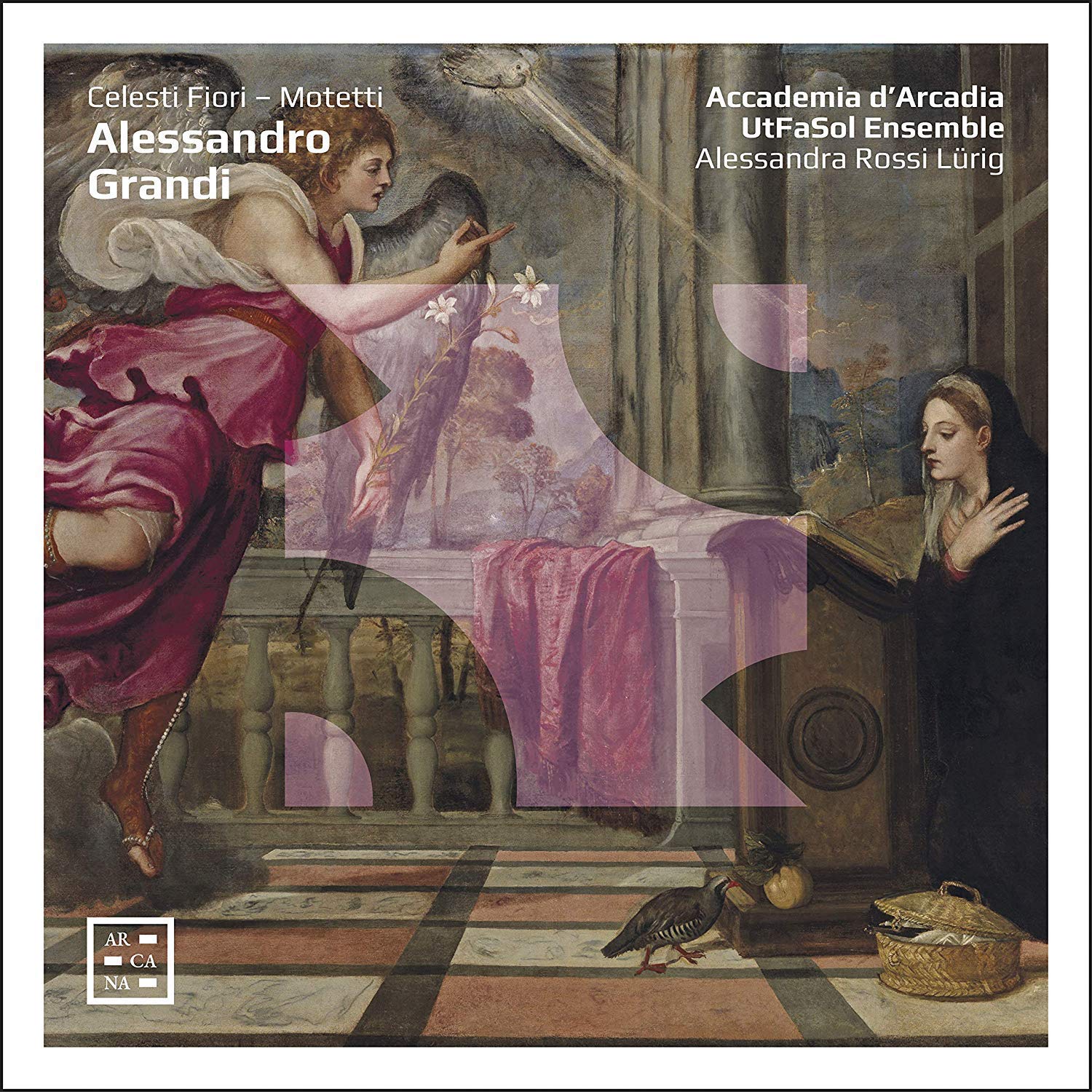
Academia d’Arcadia, UtFaSol Ensemble, Alessandra Rossi Lürig
62:39
Arcana A 464
During his lifetime, the Venetian Alessandro Grandi was regarded as the equal of Monteverdi and his influence on the motet was profound. The works recorded here illustrate the dramatic concertato style in which he composed and indicate an original creative genius at work. Blending voices and continuo with cornetti and sackbuts, these performances illustrate how he animates the texts he is setting with rapidly changing bursts of expressive musical ideas, but is also capable of more sustained expressions of passion. The singing and playing here is generally suitably passionate too, with very effective detailed ornamentation subtly applied where appropriate. I have some reservations about the soprano voices which both have more vibrato than is comfortable. Annoyingly they seem able to minimise this at will, but too often they don’t, leaving them sounding unsettlingly wobbly compared to the cornetti and, indeed, the gentlemen. The 15 motets recorded here range from simple two-voice dialogues to larger-scale pieces culminating in a handsome eight-part setting of Nisi Dominus. The recorded sound is best in the smaller-scale works and is a bit crowded in the larger pieces, where surely more use could have been made of the acoustic in the Basilica Palatina di Santa Barbara in Mantua. This CD with Alessandra Rossi Lürig’s detailed and informative programme notes makes a strong case for exploring further Grandi’s sacred music, which has survived in large quantities but of which only a small portion has made it into modern editions. [Ed. Dennis Collins’ fine editions are available from primalamusica and he is one of several editors working on a complete edition for CMM.]
D. James Ross

Christina Landshamer, Anja Scherg, Reginald Mobley, Benedikt Kristjánsson, Andreas Wolf, Gaechinger Cantorey, Hans-Christoph Rademann
79:20
Carus 83.310
In addition to the Utrecht Te Deum and Jubilate on this packed CD we get a suite from ‘Il Pastor fido’ and the Ode for the Birthday of Queen Anne. All three works belong to the period when the composer was in the employ of the Elector of Hanover but was taking extended leave in London. The story of Handel’s alienation from the Electors of Hanover and his subsequent embarrassment when George I was translated to the British throne is a complete fiction, and it seems they were more than happy to see their favourite composer established in London. That Handel successfully applied himself to major courtly compositions in the latter days of the reign of Queen Anne helped him quickly to become the archetypal British national composer. While the Utrecht Te Deum and Jubilate are pieces full of pomp designed to celebrate military victory, the Birthday Ode is more subtle indicating even a degree of affection between the Queen and her rising star composer. Opening with the sublime “Eternal Source of Light” given a fine performance here, this piece seems to show an awareness on the part of the 28-year-old composer that he is stepping into some dauntingly large shoes. In these performances, the orchestra of the Gaechinger Cantorey play with an impressive consistency and idiomatic style while the chorus too produce a pleasingly focussed and expressive sound. The soloists generally impress with their musicality and purity of tone, while the live recording made in the Liederhalle Stuttgart has a fine acoustic bloom with absolutely no audience noise.
D. James Ross

Sacred Arias at the Imperial Viennese Court
Sarah Van Mol, Oltremontano, Wim Becu
58:04
Accent ACC 24349
Music by Caldara, Conti, Emperor Joseph I, Froberger, Fux, Muffat, Pachelbel, M. A. & P. A. Ziani
The enormous affluence and political success of late-17th- and early 18th-century Vienna allowed it to support a cultural life of the highest standard, and master musicians, many of them Italian, flocked to the Imperial Court. One such was Pietro Andrea Ziani, whose nephew Marc’Antonio took his uncle’s winning formula of motets for solo voice with two obbligato violins and developed it into the distinctively Viennese form in which the violins were replaced by an obbligato trombone. A family of trombone virtuosi, the Christians, flourished in Vienna on the back of this vogue, and veteran Baroque trombonist Wim Becu – a stalwart of many period brass ensembles – brings this neglected repertoire vividly to life here. The sweet-voiced Sarah Van Mol is also a positive asset here, singing with beautiful clarity and expressiveness. Further character is added by the use of the 18th-century ‘Ziverin Orgel’ by J B Forceville for solo items by Pachelbel and Froberger, while a 2013 Jos Moors organ adds distinctive colour to a number of the ensemble motets. These are persuasive performances of repertoire which, notwithstanding pioneering work by the great René Clemencic, remains underperformed. Perhaps Vienna should reserve some of the stardust lavished so generously on the Strauss family for composers such as Georg Muffat and Johann Joseph Fux who did so much to put Vienna on the musical map.
D. James Ross
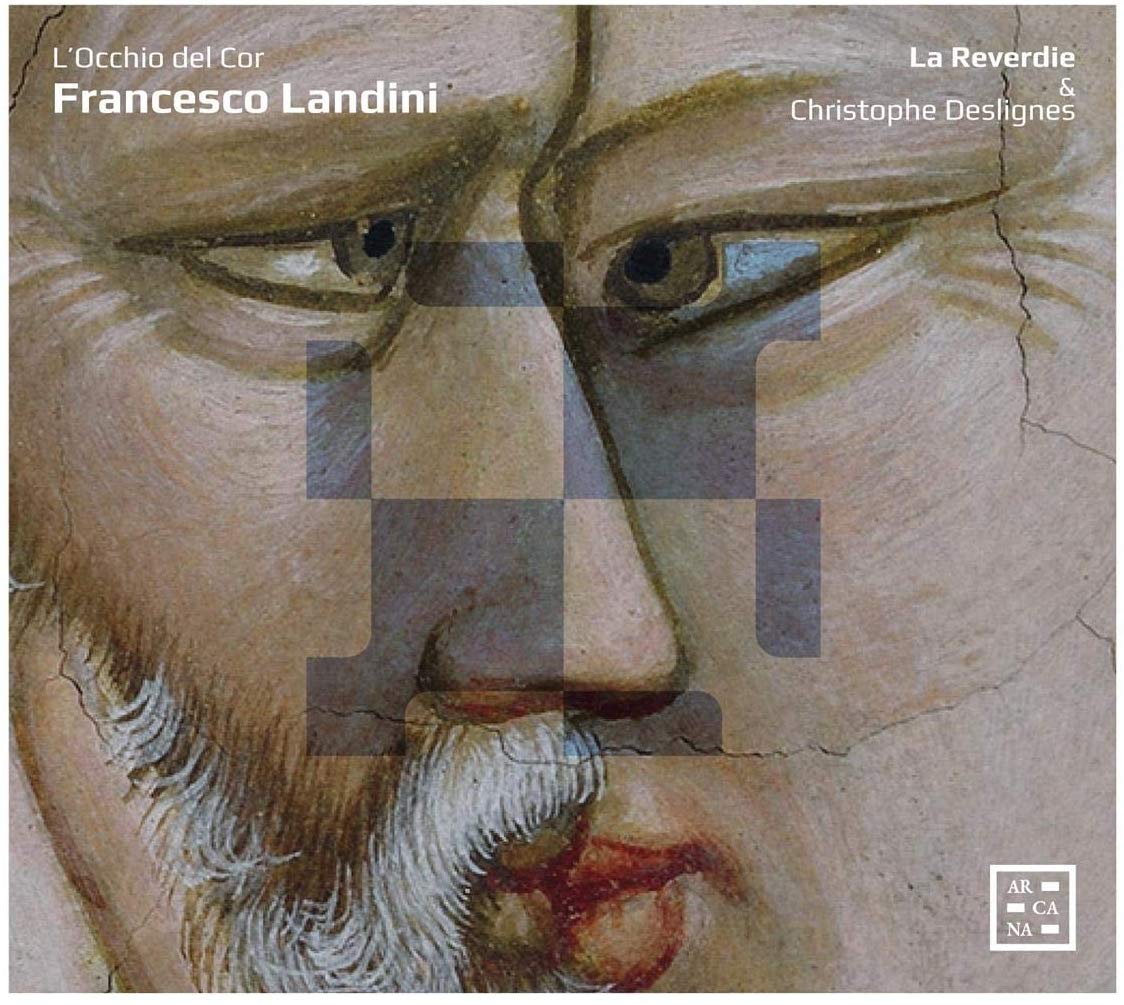
Francesco Landini
La Reverdie & Christophe Deslignes
64:56
Arcana A462
In the case of Landini the title ‘the eye of the heart’ holds an extra poignancy as the composer was blind, and many of his ballades feature sight denied, absent or otherwise thwarted. In this delightful compilation, La Reverdie have chosen specifically those songs in which sight features, interspersing them with instrumental performances of other ballades. As all five members of the group in addition to playing lute, recorders, vielles, rebec, harps and tamburello also sing, the permutations are endlessly interesting, a variety further enhanced by the organetto playing of Christophe Desligne. A profuse composer, Landini’s music comes in a bewildering variety of moods and styles, from the languidly melancholy to the frenetically dynamic. At his most creative, as in the exquisitely beautiful ballade Muort’oramai deh misero dolente, Landini plucks at the heart strings, and in these beautiful and effortlessly elegant performances his music is heard to best advantage.
D. James Ross
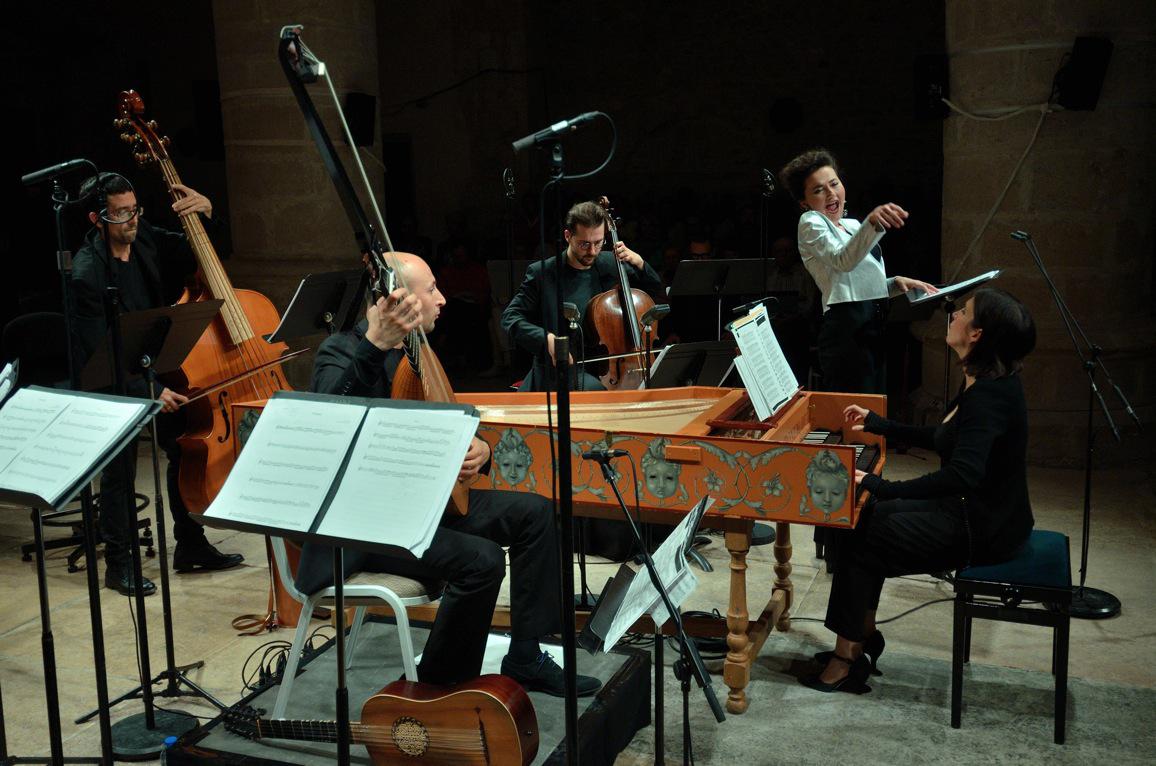
You can download this article as a PDF by clicking Ambronay40.
Photo credit: Stéphanie D’Oustrac with Amarillis – Ambronay Festival 2019 © Bertrand Pichène
Over the years I have sent many reports of the Ambronay Festival to EMR and elsewhere, so the occasion of the 40th Anniversary season has prompted me to think along rather different lines. What follows therefore is a personal retrospective covering attendance at a quarter of the total of Ambronay’s festivals. My excuse, reason – call it what you will – for doing so is the unique and treasured relationship, no less than a love affair, that has developed over that time between us (my partner Anne and myself – to whom all future references of ‘us’ or ‘we’ refer) and the festival. As with all love affairs, that has not meant blind acceptance of everything that has been seen and heard, as we will see.
First, though, let’s just remind readers who may not know that Ambronay is a small village some 35 miles northeast of Lyon, lying close to the foot of the thickly wooded hills of the Haut Bugey, pre-Alps forming a southern continuation of the mountains of the Jura. It’s a pleasant if unremarkable kind of place, the kind you might easily drive through without noticing the medieval Benedictine abbey church set back from the main street. Yet Ambronay and its abbey church, which is blessed with outstanding acoustics, are home not only to one of Europe’s most prestigious early music festivals, but also to an ambitious cultural centre of worldwide importance, founded in 2003. The festival itself was founded in 1980 by Alain Brunet, whose presence still graces the festival and about whom more later. Among artists to appear at early editions of the festival were the late Jean-Claude Malgoire and William Christie, who made his debut in 1984.
Our own first appearance at Ambronay came in 2009, the 30th Anniversary Season, which like the current celebratory season featured many of the artists particularly associated with the festival. As it happened, our first event did not take place at Ambronay itself, but in the theatre of the nearby town of Bourg en Bresse, a performance of Monteverdi’s L’incoronazione di Poppea directed by Leonardo Garcia Alarcón. That was also the night we met for the first time the festival’s international press agent, Véronique Furlan, a slight young woman who by coincidence was also experiencing her first festival. It must be confessed that on that occasion Véronique made little impression on me, but since that night she has become a much valued and indeed admired friend who, along with her husband Daniel and daughter Lila (yet to be born at the time), became a major component of the annual ‘Ambronay experience’. Véronique is one of those exceptional people with the extremely rare gift of making all those who come into her orbit feel they are of importance to her; beyond that she is quite simply the most efficient press agent I have ever encountered.
But back to that Poppea. Although the performance was a highly commendable example of the commitment Ambronay has always had to developing young artists, being given as it was by recent alumni and present members of the early music departments of the conservatoires of Lausanne and Geneva, it would also be the first of several occasions that occasioned reservations about the work of Alarcón. Here it was the conductor’s greatly inflated instrumental forces that jarred, more a large Renaissance band after the manner of Orfeo. A couple of years later Alarcón, who by then had become Ambronay’s chief artist-in-residence, presented a ‘colourful’ (to put it mildly) version of Il diluvio universale, a re-discovered oratorio by the little-known Sicilian composer Michelangelo Falvetti, an aberration made worse by the fact that that it was supposedly following a scholarly version published by Ambronay’s admirable academic research department. It does not enhance Ambronay’s credentials as an early music research centre that Alarcón’s corrupt Il diluvio, with its ‘world music’ interpolations – Ambronay has a strong folk ‘fringe tradition’ – was revived for the 40th Anniversary season.
In the early years of visits to Ambronay we were living in France, little more than an hour’s drive on the autoroute. It meant that we were able to attend concerts throughout the festival’s four weekends, traditionally held from the second weekend in September to the first in October and that first year we feasted on a range that covered a gamut from Handel’s oratorio Susanna directed by William Christie to the rarely heard intermedi for La pellegrina that formed part of the 1589 Medici wedding celebrations, performed by suitably lavish forces under the direction of Skip Sempé. Notwithstanding such large-scale pleasures, the most memorable concert of that year was a more intimate affair, a programme devoted to chamber settings of Vespers for the Virgin given by Concerto Soave, a concert dominated by Maria Cristina Kiehr, a singer whom I noted exuded ‘an aura of calm repose when not singing and a mesmerising hold on an audience when she is’. Two years later, Kiehr and Concerto Soave would prove equally entrancing in a cycle of works by such as Mazzocchi and Monteverdi devoted to episodes in the life of Christ.
In those days, the solo and small-scale concerts took place in the medieval Tour Dauphine, situated in the abbey grounds, later restored and today the mess where artists, Ambronay staff and invited visitors take their meals. This interaction is, I’m sure, one of the reasons for the agreeable ambiance of the festival. It was in the Tour we first heard (in a recital of Haydn songs) Stéphanie d’Oustrac, a young mezzo and alumnus of Ambronay’s Baroque Academy who was already starting to make waves at the start of what has since become an international career. Happily d’Oustrac was able to take part in Ambronay 40, giving the only concert we heard this year, a recital entitled ‘Éclats de folie’ (outbursts of madness) with the ensemble Amarillis, a subject eminently suited to a singer that has always shown a gift for strong dramatic projection. Here d’Oustrac was probably most successful in Purcell’s ‘Bess of Bedlam’ and ‘From Rosy bowers’ (Don Quixotte), her performances of Handel’s cantata ‘Ah, crudel’ (HWV 78) , and French repertoire by Campra, Marais and Destouches (extracts from Sémélé ) a little marred by what has become a fairly wide vibrato doubtless developed as a result of the singer having moved on to later, heavier repertoire. On their own, the accomplished Amarillis gave performances of works by Heinichen, Rebel, Eccles and Keiser.
In 2011 our visits to Ambronay underwent a fundamental change that would enhance our future relationship with the festival and those that administer it. This year the warmth and hospitality extended even to critics (!) was further enhanced by the offer of weekend accommodation in the newly and beautifully restored late 17th-century wing of the abbey complex, formerly the monks’ cells. We took advantage of this offer on the opening weekend, apparently the first people to stay in the spacious room we occupied since its restoration. It was tempting to imagine we might just have been its first occupants since the monk whose home it was in pre-Revolutionary days. Staying on the premises meant that since that time we have developed ever greater ties with the wonderful permanent and voluntary staff that make Ambronay what it is. Over the years these have become lasting friendships with many people, extending from founder and long-time general director Alain Brunet, the vivacious Mme Brunet and their charming daughter Marie to the be-whiskered doorman who now never fails to greet me without an enormous hug.
Our first concert that year also provided an introduction to an ensemble with whom another lasting friendship has developed. For critics, friendships with artists are always difficult territory, but such is the strong group personality and infectious delight in music making always displayed by Les Esprits Animaux, then one of Ambronay’s young ensembles in residence, that such reservations rather tended to be swept aside. Subsequent encounters with their seven members have always been hugely enjoyable, a concert they gave in 2017 in the church of the famous medieval fortress village of Pérouges, some 40 kms from Ambronay, remaining vividly in the mind. About that concert I wrote that ‘the players have matured into a truly outstanding chamber ensemble that now plays with real finesse and finish without having lost any of the vitality and evident pleasure they derive from making music together.’ Sadly we missed Les Esprit’s appearance at Ambronay 40. Incidentally, mention of Pérouges reminds me that it should be stressed that the festival has always been happy to ‘outsource’ its events over the region, having a strong relationship with Ain, the département in which it is located.
Both as an institution and in regard to the fabric of the wonderful location it occupies, the Ambronay Festival has never stood still. In 2012 the Tour Dauphine was replaced by the Salle Monteverdi, a renovated space lying within the main abbey complex and serving as a rehearsal hall in addition to becoming the main venue for smaller-scale concerts. It therefore became the location for the final assessments of a newly-established EU initiative with the less than beguiling name of eeemerging. Designed to give young early music ensembles residencies at early music festivals and concert series throughout Europe, initially four, later six, groups compete annually in front of the directors of festivals with which Ambronay interacts (including York), while audiences are invited to make their own choice. Over the years we have attended, the overall standard has been exceptionally high, making it an encouraging experience that renews faith in the future of early music. It has to be confessed, though, that I have rarely been in agreement with the verdict of the distinguished jury.
It would be probably somewhat tedious for readers to provide a listing of all the notable concerts we’ve attended at the Ambronay Festival over the years, but even as I write memories tumble into my head. So I hope I will be forgiven for mentioning a few of the most special ones. Sigiswald Kuijken, for some inexplicable reason the least celebrated of the great pioneers of the early music revival, is one of many who has had a special relationship with Ambronay, particularly its Academy. The late Clifford Bartlett, the founder of EMR, once wrote of how one can sometimes completely out of the blue encounter an amazingly powerful musical experience. Kuijken’s 2011 Mass in B minor was such an occasion. The one-per-part performance was shared between thirteen young singers, giving an opportunity for a large number to participate in one of the most challenging works in the repertoire. As I recorded, ‘The near-unbelievable musical quality and deep commitment of the performance was a tribute to those who had coached these young performers from no fewer than 20 countries, above all Kuijken, who produced an utterly dedicated performance that fused all his wisdom and long experience with fresh, exceptional talent’, producing ‘a performance that ultimately provided me with one of the most moving experiences of a long musical life, an experience that was about so much more than just music.’
Unquestionably the most memorable events of more recent years are the two concerts of Monteverdi madrigals given in 2015 and 2016 by a vocal ensemble drawn from Les Arts Florissants under the direction of Paul Agnew. The first, devoted to a selection taken from Books I to III featured performances with ‘textures and chording marked by superb finesse and finish’, but in which Agnew at times inspired his singers ‘to near operatic dramatic intensity’. ‘Throughout this compelling programme’, I concluded, ‘Agnew, who directed with understated authority as an ensemble member, seemed to be living every moment, each note.’ The following year Agnew gave extracts from Books IV, V and VI, which I described as, ‘searing, vividly dramatic and expressionistic performances. This was, quite simply, music making that scorched itself into the soul.’
And so Ambronay has reached another landmark. Surprisingly little has changed over the decade we have known it. Naturally there have been arrivals and departures, the departure of sécretaire générale Catherine Jabaly, who was so kind to us in the early years was a sad moment, while the ever-amenable Alain Brunet, who had been looking increasingly tired, handed over the reigns of the general directorship to Daniel Bizeray after the 2013 season. Relieved of the burden, Alain has now become president and gained a new lease of life, happily as much in evidence at the festival as he ever was.
Unsurprisingly Ambronay 40 brought in to celebrate an influx of luminaries who had long been associated with the festival, among them William Christie, Jordi Savall, Christophe Rousset and countertenor Philippe Jaroussky, along with more recent additions to the French early music scene such as Sébastian Daucé’s outstanding Correspondances. The prime reason for our attendance – other commitments regrettably making it a brief visit – was Rousset’s fine performance of Handel’s Giulio Cesare, dominated by the magnificent Sesto of Ann Hallenberg, one of the great mezzos de nos jours. But you’ll have to go to Opera magazine to read my full review of that. Should you go to Ambronay if you’re an early music enthusiast who has not yet been? Assuredly. Set aside next September now. Will I be there to celebrate Ambronay 50? Certainly, if destiny allows, for true love only grows even stronger with the years, and, to re-quote my earlier words, Ambronay is about ‘so much more than just music’.
Brian Robins
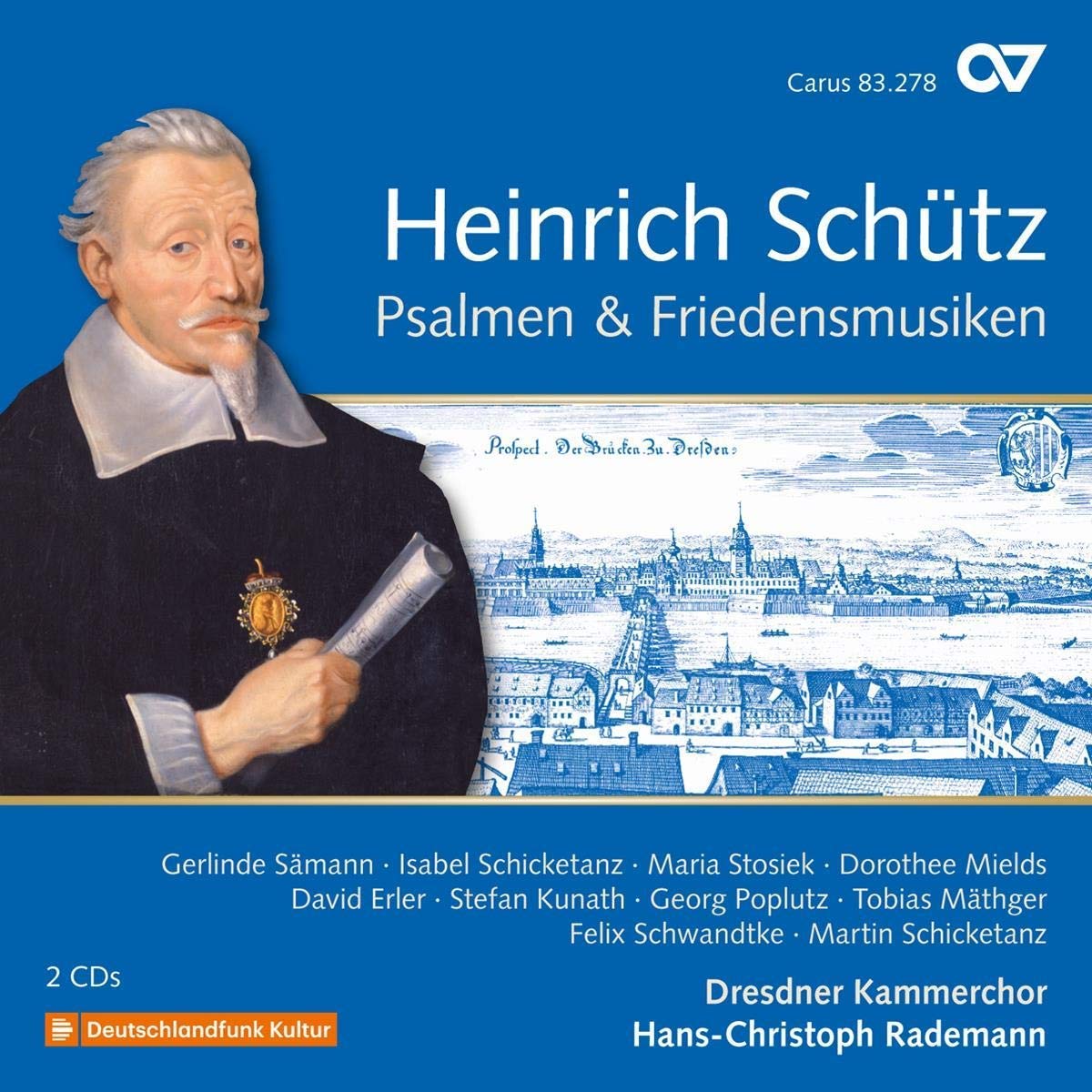
Complete recording, Vol. 20.
Gerlinde Sämann, Isabel Schicketanz, Maria Stosiek, Dorothee Mields, David Erler, Stefan Kunath, Georg Poplutz, Tobias Mäthger, Felix Schwandtke, Martin Schicketanz, Dresdner Kammerchor, Instrumentalisten, Hans-Christoph Rademann
138:05 (2 CDs in a box)
Carus 83.278
These two CDs mark the end of Hans-Christoph Rademann’s complete recording of Schütz in collaboration with the publishers Carus that began in 2006. CD1 includes a number of psalm settings (127, 15, 124, 137, 85, 116, 8 and 7) and the Whitsun Sequence, while CD2 has commissioned works for public occasions, a couple of biblical dialogues, and music of a more personal nature, like Schütz’s ode to his wife who died (aged 24) in 1625. The astonishing variety of music represented here alerts us to the significance of Schütz’s oeuvre spanning the long period of his life from the madrigals composed under the influence of his teacher Gabrieli in Venice, through the richly scored psalms of his early maturity to the biblical dialogues and solo songs, with their minimalist instrumental colouring, of his middle age and maturity, and also to the breadth of his commissioned work.
The team of singers for the single-voice performances of much on these discs is a starry double SSATB quintet with Gerlinde Sämann, Isabel Schickentanz, Dorothee Mields, Georg Poplutz and Tobias Mätheger among their number. Many have connections to the Dresdener Kreuzchor or Kammerchor, like Rademann himself, and the Dresdener Kammerchor here is a fine foil to the solo voices with whom they share the same timbre as the opening psalm, Nisi Dominus (SWV 466), reveals at once. Psalm 15 (SWV 473) that follows it has two contrasting cori, one of alto & bass with two violins and violone, the other soprano & tenor with three trombones. In Psalm 137 – By the waters of Babylon – the verses of lament are given to the chorus tenors with four trombones while those that tell of the hanging up of their harps are sung by two solo sopranos and bass with two theorbos and continuo.
By contrast, the four choirs in the Latin Sequence Veni Sancte Spiritus – two sopranos & fagotto, two cornetti & bass, two tenors & three trombones, alto & tenor with two violins & violone – are not all heard together till the opening chords of verse 4, when Schütz’s characteristic G major to E major shift illuminates the words O lux, and some bars of 6/8 invigorate the heavenly rewards promised. CD1 ends with Psalms 8 and 7 and some of the niftiest trombone playing I have heard amongst other delights. The balance between voices and instruments is excellent, and the ringing clarity of the whole ensemble makes these fine performances under the experienced and sure-footed Rademann.
On CD2, big public works like Da pacem and an immense setting of the Benedicite with a wide variety of instrumental accompaniment to colour the text contrast with the chamber quality of Tugend ist der beste Freund (SWV 442), the strophic Danklied (SWV 368) with its instrumental ritornelli and the solo song Mit der Amphion zwar (SWV 501) that Schütz wrote on the death of his wife. Especially interesting in this category of smaller scale works are the two biblical dialogues – the well-known Easter dialogue (SWV 443) Weib, was weinest du with pairs of soprano and tenor voices for the dialogue between Mary Magdalene and Jesus, and the enchanting Vater Abraham (SWV 477) with its sinfonias for pairs of violins with the rich man (B) and recorders with Abraham (T) probably dating from the 1620s and new to me.
The greater variety of styles shown in CD2 makes this pair of CDs as good an introduction to Schütz as one could imagine. This is not the sweep up of oddments that the final volume of a series often is. If you do not know the long-lived Schütz to be the major figure in German music in the 17th century, buy this volume and start from here.
David Stancliffe